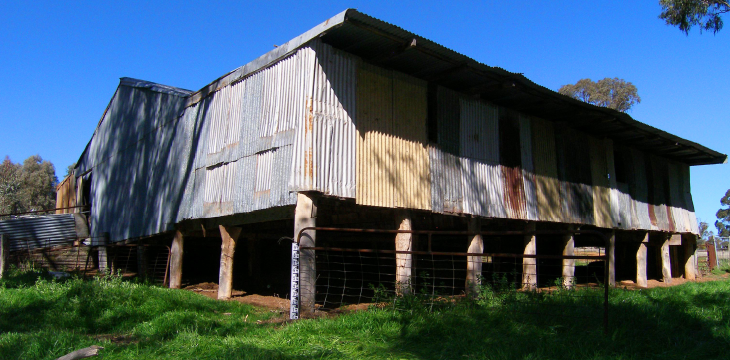Cadia Village & Hinterland
- Hinterland
- Cadia Village, a brief description, 1861-1868
- The founding members of the Cadia Mining Community, 1861-1867
- “The miners have all left the place”, 1867-1869
- Stores, shops and hotels, 1861-1868
- Cadia Post Office, 1864-1920s
- Cadia Public School, 1865-1945
- A matter of Faith – the role of the Church at Cadia
- The Case of Benjamin Derrett, storekeeper
- Closer settlement of the Landscape, 1860s onwards
- Cadia Village, 1870s – 1940s
Closer settlement of the Landscape, 1860s onwards

Shearing sheds are characteristic of the Cadia hinterland and demonstrate the importance of wool production in the regional economy. This shearing shed is located at Wire Gully (Edward Higginbotham, 2009).
Because the Company owned the land, the miners and their families were excluded from purchasing allotments for their own homes. Ultimately this would limit capital investment, one of the reasons that Cadia Village did not survive. While shopkeepers and others could take out leases on which to erect their own buildings, freehold title was only available beyond the mine boundaries. To a certain extent this suited the miners, because they realised that after Cadia ended, they would have to search for other opportunities, leading a restless life pitted against the needs of the family for a stable home and education.
Earlier large scale pastoral settlement of New South Wales had effectively excluded small settlers from owning land. After agitation for reform, the Robertson Land Acts (Crown Land Alienation Act) of 1861 finally provided a mechanism whereby smallholders could purchase Crown land by instalment and by completion of various improvements.
Only a few of the persons at Cadia took advantage of these regulations in the early 1860s, including Dr. Matthew Blood, his son, William Smyth Blood, as well as Josiah Holman, all from the mining elite.
Prior to 1864, much of the land near the Cadia mine was not occupied. When squatter, Gustavus Richard Glasson, became aware of this, he asked that the land be put up for lease by auction, and he successfully bid for the lease. On 29 March 1866, Gustavus Richard Glasson ran 1,400 mixed wethers, 1,880 mixed ewes, 600 lambs and 64 rams, a total of 3,944 sheep on his land in the Parish of Clarendon, which he duly mortgaged to the Commercial Banking Co of Sydney for £700.
The leasehold threatened to deprive the Cadia community of feed for the teamsters’ horses and bullocks, as well as timber for fuel, most importantly for the smelting works. In 1866 the Cadia residents and miners successfully petitioned for a Common to be declared around the mine to reserve these resources. But a further consequence of the Common was that it restricted Conditional Purchases in the area until 1879 when the Common was revoked.
The closure of the mine in 1867-1868 clearly defines the choices made by the Cadia community members for their own future livelihoods. It reveals their life goals and ambitions, tempered by personal and family circumstances and economic constraints. There is substantial evidence to suggest that the majority of the Cornish miners and Welsh smelters left the district to find mining opportunities elsewhere, even if only a short distance away. The career paths of the mining elite have already been described, as well as the miners’ strategy of leaving their families at Cadia until new work opportunities became certain.
Most of the miners decided not to settle on the land at this time, even though it was almost certainly a life goal for many of them. Economic necessity forced this decision on them.
Even with the generous provisions of the Crown Land Alienation Act of 1861, developing a small farm was not in fact an economic proposition. It demanded a greater level of capital than most possessed, family support and also supplementary work to build up a sufficient landholding to make farming and grazing viable. This process is illustrated by the example of a number of people who lived and worked in and around Cadia.
A number of those at Cadia did choose to purchase farms in the district. Providing they could still obtain employment at Cadia or in the surrounding area, whether mining or otherwise, then some could afford to live on the land, even though they might not have the capital ultimately to build up a large landholding.
“The mine is looking very dull the people are gradually leaving most of them having selected or bought farms about the neighbourhood…” (extract from a letter written by Emma Holman, wife of Josiah Holman, junior, to her father, James Burfitt on 29 December 1877).
The process of amalgamation of landholdings into larger and more economic units nonetheless proceeded relentlessly from the 1870s to the mid 1900s. Smaller holdings were swallowed up and farm mechanisation removed many of the labour intensive activities of the past, resulting in the depopulation of the rural landscape. Sheep shearing is one of the only labour intensive farming activities that has survived to the present day.
The closer settlement of the rural landscape around Cadia enabled the Village to survive the downturn in mining, albeit in a more constrained fashion.
When the second boom in mining ended in 1928, the Village was not so lucky, because by then the processes depopulating the rural landscape were well under way. When the Iron Duke was re-opened in the Second World War, new staff housing had to be built and a temporary tent city established, because little survived in the Village itself.